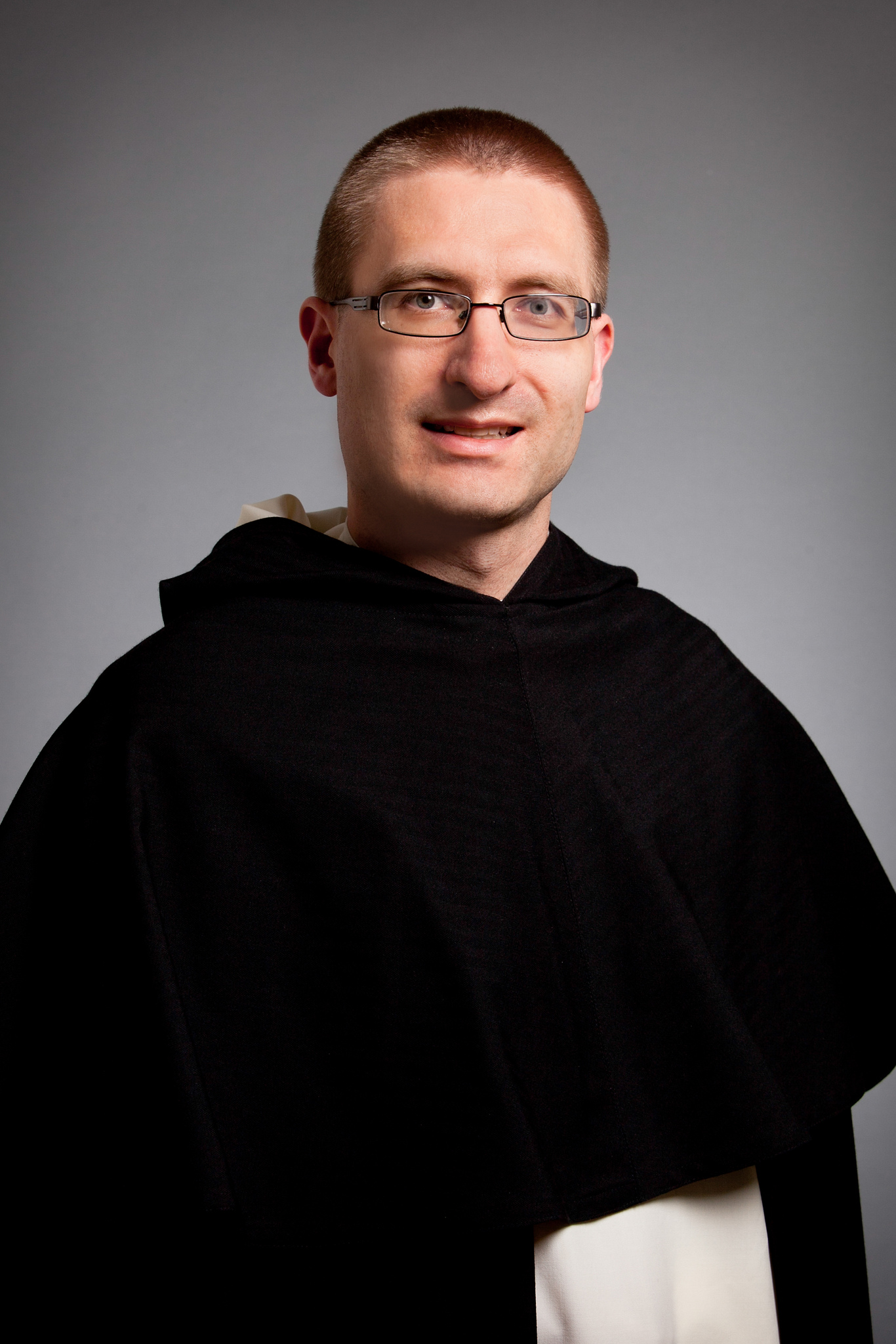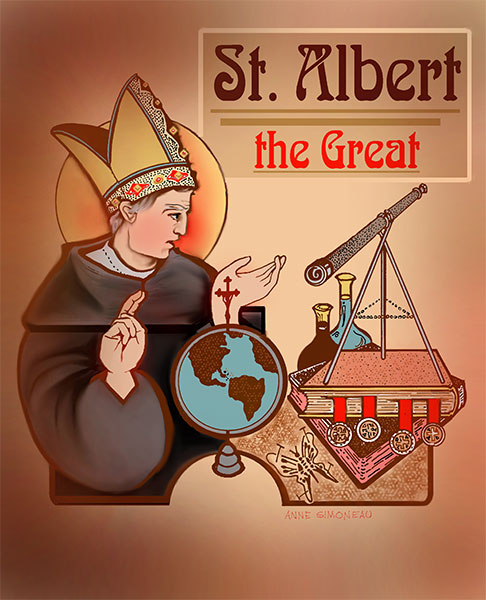
– by Br Humbert Kilanowski, OP, (Br. Humbert Kilanowski entered the Order of Preachers in 2010. He earned a doctorate in mathematics from The Ohio State University and did his undergraduate studies at Case Western Reserve University.)
“Before I entered the Dominican Order, I taught an introductory statistics class at a small college founded by Dominican Sisters in my hometown. Since the school was too small to have distinct departments for each scientific field, all of them, including mathematics, were housed in St. Albert Hall, a building named for today’s patron saint. A fitting attribution—for the thirteenth-century German Dominican friar was an expert not only in philosophy and theology, but also in several natural sciences: constructing an early greenhouse, discovering the chemical element arsenic, and developing experimental methods that would later become standard in modern science. For his integration of scientific domains and the newly-rediscovered philosophy of Aristotle with the study of divine revelation in theology, Saint Albert the Great is fittingly honored as the Doctor Universalis, the “teacher of everything.”
In today’s academic climate, however, a “teacher of everything” is hard to find. Departments and disciplines have become so specialized that lectures given on one topic are often barely understood by others in the same department, and whole conferences and journals are devoted to the narrowest of subfields. In learning to be an expert in one area, other fields are ignored, to the point that scholars in the sciences can deem theological claims to be either over their heads or not worth their attention. Without a unifying vision of all knowledge, one may even reach the conclusion that science and theology contradict each other, as seen in the debates between random evolution and intelligent design, for example. How can a seeker of truth resolve this dilemma?
One scholar, the evolutionary biologist and agnostic Stephen Jay Gould (d. 2002), proposed a solution: that of “non-overlapping magisteria.” In this model, which he described in a 1997 article, both science and religion have separate domains over which each has competency, and neither one impinges on the other. As he writes:
The net of science covers the empirical universe: what is it made of (fact) and why does it work this way (theory). The net of religion extends over questions of moral meaning and value. These two magisteria do not overlap, nor do they encompass all inquiry (consider, for starters, the magisterium of art and the meaning of beauty). To cite the arch clichés, we get the age of rocks, and religion retains the rock of ages; we study how the heavens go, and they determine how to go to heaven.
The separation of domains of teaching authority, or “magisteria” as Gould appropriates the word, seems attractive; Christians believe that God created the human race directly in His image and likeness on theological grounds, for example, and biologists hold that humanity came to be through a long evolutionary process of many random mutations on scientific grounds. The dignity of the human race as being in the image of God is primarily a moral statement, while the origin of the species is a theory based on empirical data, and the two explanations seem to fall into disparate domains.
Yet, the various magisteria do, in fact, inevitably overlap. Another evolutionary biologist, the outspoken atheist Richard Dawkins, replies:
It is completely unrealistic to claim, as Gould and many others do, that religion keeps itself away from science’s turf, restricting itself to morals and values. A universe with a supernatural presence would be a fundamentally and qualitatively different kind of universe from one without. The difference is, inescapably, a scientific difference. Religions make existence claims, and this means scientific claims.
In other words, if God is held to be the Creator of the universe, then He has a direct effect on all that exists (namely, He bestows existence on it), and everything studied in science, or art, or history, can be considered in relation to God. While Dawkins’ analysis limps in asserting that claims of existence are scientific, for many things exist that are not subject to natural science, he properly identifies that theology does exert an influence on science.
To investigate how these bodies of knowledge overlap and interact with each other, it helps to examine the work of St. Albert’s most prominent student, St. Thomas Aquinas, OP. He explains that theology “has no concern to prove the principles of other sciences, but only to judge of them” (ST, I, 1, 6, ad 1), and that it “can in a sense depend upon the philosophical sciences, not as though it stood in need of them, but only in order to make its teaching clearer” (ST, I, 1, 5, ad 2). To continue with the example, theology tells biology that it cannot exclude divine activity in forming the human race (especially with regard to the immaterial soul by which we reason and choose freely), while biology provides the details of how the human body was formed from the earth. Both fields, taken together, give a fuller and more robust understanding of what is to be known. By considering the relationship of theology to the other sciences, we can see how each field of study aims at the same truth according to its own method.
In this, we should follow the example of St. Albert the Great, who saw in everything that he studied the God who made it and to whom it is ultimately ordered. Surely, as Pope Leo XIII remarked, “Truth cannot contradict truth”; hence, let us join the “teacher of everything” by allowing everything we study to lead us to the contemplation of God, the Supreme Truth.”
“I adore You, O Precious Blood of Jesus, flower of creation, fruit of virginity, ineffable instrument of the Holy Spirit, and I rejoice at the thought that You came from the drop of virginal blood on which eternal Love impressed its movement; You were assumed by the Word and deified in His person.
I am overcome with emotion when I think of Your passing from the Blessed Virgin’s heart into the heart of the Word, and, being vivified by the breath of the Divinity, becoming adorable because You became the Blood of God.
I adore You enclosed in the veins of Jesus, preserved in His humanity like the manna in the golden urn, the memorial of the eternal Redemption which He accomplished during the days of His earthly life.
I adore You, Blood of the new, eternal Testament, flowing from the veins of Jesus in Gethsemane, from the flesh torn by scourges in the Praetorium, from His pierced hands and feet and from His opened side on Golgotha. I adore You in the Sacraments, in the Eucharist, where I know You are substantially present….
I place my trust in You, O adorable Blood, our Redemption, our regeneration. Fall, drop by drop, into the hearts that have wandered from You and soften their hardness.
O adorable Blood of Jesus, wash our stains, save us from the anger of the avenging angel. Irrigate the Church; make her fruitful with Apostles and miracle-workers, enrich her with souls that are holy, pure and radiant with divine beauty. Amen.”
-St Albert the Great, OP
“He who enters into the secret place of his own soul passes beyond himself, and does in very truth ascend to God. Banish, therefore, from thy heart the distractions of earth and turn thine eyes to spiritual joys, that thou mayest learn at last to repose in the light of the contemplation of God.”
–St. Albert the Great
“Now there’s no one who approaches God with a true and upright heart who isn’t tested by hardships and temptations. So in all these temptations see to it that even if you feel them, you don’t consent to them. Instead, bear them patiently and calmly with humility and long suffering.”
—St. Albert the Great
Love,
Matthew



